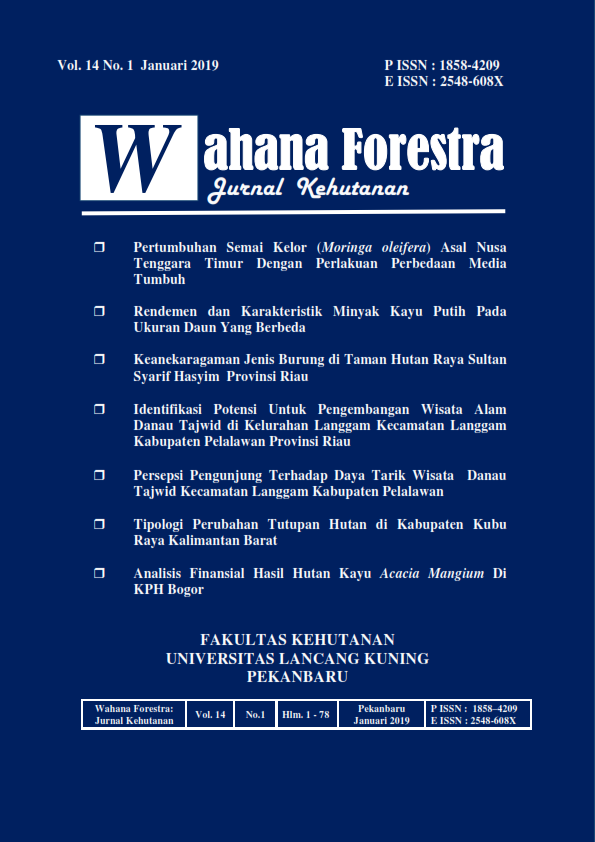TIPOLOGI PERUBAHAN TUTUPAN HUTAN DI KABUPATEN KUBU RAYA KALIMANTAN BARAT
DOI:
https://doi.org/10.31849/forestra.v14i1.2460Keywords:
West Kalimantan, typologies, driving forcesAbstract
Forest cover changes were influenced by many factors, some of which were biophysical characteristics, socio-economic conditions, and community cultural. The behavior of forest cover changes in each of Indonesia's regions varied, either its rate or its driving factors. The establishment of village typologies to categorize village administrative areas becomes important to see the driving factors that trigger forest change in each typology. The objective of this study was to develop the village typology and to identify the driving forces of forest cover change in each village in Kubu Raya Regency, West Kalimantan. The development of village typology was done by applying the clustering approach with standardized euclidean distances. Based on the proportion of forest in 2015, the study found that there are two village typologies within the study area with 81% OA. The study also recognized that the most significant driving forces of forest cover change in T1 were the distance from rivers (X2) and settlements (X3), whereas in T2 were the distance from roads (X1) and the edge of forest in 2015 (X9). The study concludes that the proximity from the center of the human activities holds a significant influence on the behavior of forest cover changes.
References
[FWI] Forest Watch Indonesia. 2014. Potret Keadaan Hutan Indonesia Periode Tahun 2009-2013. Bogor (ID): Forest Watch Indonesia.
Ahmad A, Saleh MB, Rusolono T. 2015. Model spasial di KPHP Poigar, Provinsi Sullawesi Utara. Jurnal Penelitian Kehutanan Wallacea. Vol.5 No. 2 :159-169
Albar I, Jaya INS, Saharjo BH, Kuncahyo B. 2016. Spatio-temporal typology of land and forest fire in Sumatra. Indonesian Journal of Electrical Engineering and Computer Science. Vol.4 No. 1 :83-90.
Bennet G. 2015. Modelling Regeneration and Deforestation in the Atlantic Forest Brazil [Tesis]. London (GB): Imperial College London.
Curran LM, Trigg SN, McDonald AK, Astiani D, Hardiono YM, Siregar P, Caniogo I, Kasischke E. 2004. Lowland forest loss in protected areas of Indonesian Borneo. Science. Vol. 303:1000-1002.
Deng X, Huang J, Uchida E, Rozelle S, Gibson J. 2011. Pressure cookers or pressure valves: Do roads lead to deforestation in China. Journal of Environ Economics and Management. Vol.6 No. 1 :79-94.
Geist HJ, Lambin EF. 2001. What Drives Tropical Deforestation. A meta-analysis of proximate and underlying causes of deforestation based on subnational case study evidence. LUCC Report Series (4). Belgia (BE): University of Louvain.
Jauhiainen J, Heikkinen J, Martikainen PJ, Vasander H. 2001. CO2 and CH4 fluxes in pristine peat swamp forest and peatland converted to agriculture in central Kalimantan, Indonesia. International Peat Journal. Vol. 11 :43-49.
Lastini T. 2012. Tipologi Desa Hutan Rakyat: Kasus di Kabupaten Ciamis [Disertasi]. Bogor (ID): Institut Pertanian Bogor.
Pang C, Yu H, He J, Xu J. 2013. Deforestation and Changes in Landscape Patterns from 1979 to 2006 in Suan County, DPR Korea. Forests. Vol. 4:968-983.
Popradit A, Srisatit T, Kiratiprayoon S, Yoshimura J, Ishida A, Shiyomi M, Murayama T, Chantaranothai P, Outtaranakorn S, Phromma. 2015. Anthropogenic effects on a tropical forest according to the distance from human settlements. Scientific Reports. Vol. 5:1468.
Setiawan H. 2015.Model Spasial Perubahan tutupan hutan di Kabupaten Konawe Provinsi Sulawesi Tenggara [Disertasi]. Bogor (ID): Institut Pertanian Bogor.
Siswoko BD. 2008. Pembangunan, deforestasi dan perubahan iklim. Jurnal Manajemen Hutan Tropika. Vol. XIV No. 2:88-95.
Sulistiyono N, Jaya INS, Prasetyo LB, Tiryana T. 2015. Spatial model of deforestation in Sumatera islands using typological approach. Jurnal Manajemen Hutan Tropika (Journal of Tropical Forest Management). Vol. 21 No. 3:99-109.
Sulistiyono N, Jaya INS, Prasetyo LB, Tiryana T. 2015. Spatial model of deforestation in Sumatera islands using typological approach. Jurnal Manajemen Hutan Tropika (Journal of Tropical Forest Management). Vol. 21 No. 3:99-109.
Valbuena D, Verburg PH, Bregt AK. 2008. A method to define a typology for agent-based analysis in regional land-use research. Agriculture, Ecosystems & Environment. Vol. 128 No. 1 :27-36.
Wijaya PA, Saleh MB, Tiryana T. 2015. Spatial model of deforestation in Jambi Province for the periode 1990–2011. Jurnal Manajemen Hutan Tropika. Vol. 21 No. 3:128-137.
Zulkarnain. 2014. Analisis Keuangan Daerah Kabupaten Kubu Raya Dalam Rangka Pelaksanaan Otonomi Daerah dan Faktor-Faktor yang memengaruhinya [Tesis]. Pontianak (ID): Universitas Tanjungpura.






